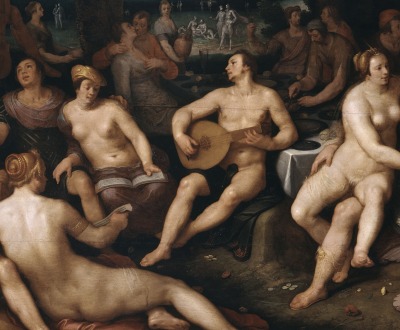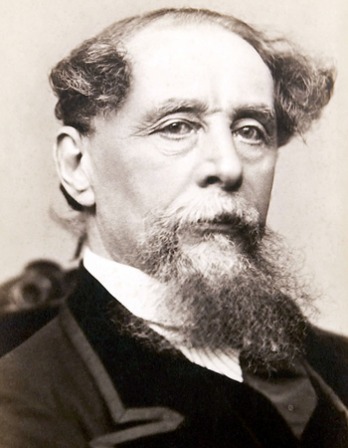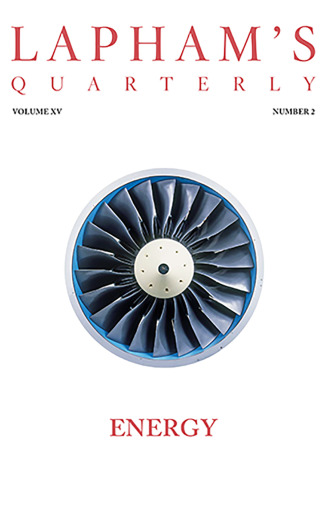
Mankind Before the Flood, by Cornelius Cornelisz, 1615. © RMN-Grand Palais / Art Resource, NY.
The circumstance of superior beauty is thought worthy attention in the propagation of our horses, dogs, and other domestic animals; why not in that of man?
—Thomas Jefferson
Jefferson was a philosopher, politician, and gentleman farmer who answered his uplifting question with the drafting of the Declaration of Independence, the founding of the University of Virginia, and the begetting of his image on those among his slaves he deemed worthy of attention. Live births to black women in his possession increased the extent and value of his property, and the master of Monticello was not alone among the founding fathers in viewing human flesh as a consumer good and service. The point bears mentioning in the context of this year’s presidential election. On the campaign roads to life, liberty, and the pursuit of happiness, Hillary Clinton and Donald Trump juggle the weights and measures of the flesh—its color, cost, gender, sell-by date, and stereotype—that ground the election on the divisions of race and class.
The divisions were present at the American creation. The planting of colonies in seventeenth-century America conformed to the design of Europe’s medieval socioeconomic structures, feudal arrangements of privilege and subordination, not to an originalist democracy. The aristocratic promoters of the project received land as a gift from the English king; the improvement of the property required immigrants (God-fearing or fortune-seeking) skilled as fishermen, farmers, salt makers, and mechanics. Their numbers were unequal to the tasks at hand, and in both the plantation South and merchant North the developers imported African slaves as well as “waste people” dredged from the slums of Jacobean England—vagrants, convicts, thieves, bankrupts, strumpets, vagabonds, lunatics, and bawds obliged to pay their passage across the Atlantic with terms of indentured labor on its western shore.
The prosperous gentry already settled on that shore regarded the shipments of “human filth” as night soil drained from Old World sewers to fertilize New World fields and forests. By the time the colonies declared their independence from the British crown, the newborn American body politic had been sectioned, like the carcass of a butchered cow, into the pounds and pence of prime and subprime flesh.
Few signatories to the declaration were of the opinion that all men are created equal. Maybe in the eye of God, but not in the bestowing of pews in Boston’s Old North Church, in the streets of Benjamin Franklin’s Philadelphia, on George Washington’s Mount Vernon estate. The Calvinist doctrine of predestination divided the Massachusetts flock of Christian sheep into damned and saved, Cotton Mather in 1696 reminding the servants in his midst, “You are the animate, separate, active instruments of other men…your tongues, your hands, your feet, are your masters, and they should move according to the will of your masters.”
Franklin, enlightened businessman and founder of libraries, looked upon the Philadelphia rabble as coarse material that maybe could be brushed and combed into an acceptable grade of bourgeois broadcloth. His Poor Richard’s Almanack offered a program for turning sow’s ears if not yet into silk purses then into useful tradesmen furnished with a “happy mediocrity.” For poor white children in Virginia, Jefferson proposed a scheme of public education he described as “raking from the rubbish” the scraps of intellect and talent worth the trouble of further cultivation. The majority were released into a wilderness of ignorance and poverty, their declining fortunes recalled this past summer in Nancy Isenberg’s timely book White Trash: The 400-Year Untold History of Class in America. A professor of American history at Louisiana State University, she follows the trail of the unwholesome poor on the Atlantic Seaboard (in Virginia and the Carolinas, Massachusetts and New York) dispersed into the westward-moving breeds of an American underclass (“hillbilly,” “cracker,” “Okie,” “redneck”) now said to be voting for Donald Trump.
Isenberg’s story is not untold, but in our schools and opinion-making media it is seldom remembered and preferably forgotten. Black lives have always mattered less than white lives, and so have rich lives mattered more than poor lives. Jefferson had been clear on the point in a letter to John Langdon in 1810: “Money, and not morality, is the principle of commerce and commercial nations.”
At no moment in its history has America declared a lasting peace between the haves and the have-nots. Temporary cessation of hostilities but no permanent bridging of the social divide between debtor and creditor, and never has an equal value been assigned to the flesh decorating high-end capital and degrading low-end labor. Throughout most of the eighteenth century, the academic ranking of students at Yale College aligned with the social standing of their fathers; the nineteenth century’s Industrial Revolution brought with it a steady state of class warfare in New Jerusalem’s satanic mills, factories, and mines.
Hostilities in the domestic theaters of operation were suspended for the duration of World War II. My coming of age in the late 1940s and early 1950s entailed learning from books that all human flesh—the stuff that love and war and self are made of (masculine and feminine, white or black or red or brown)—is, by definition, subprime. The lesson followed from Plato in the fifth century bc, answering Jefferson’s question with the instruction to “regard the beauty of minds as more valuable than that of the body,” to know that the mind gives birth to “magnificent discourses and ideas,” which are immortal, and therefore why “everyone would prefer to have children like that rather than human ones,” who are perishable.
Fortunately for the survival of the human race, everyone doesn’t prefer to have children like that, but Plato’s thought translated over time into the Christian religion’s locating of vice in the substance of the flesh, virtue in the abstraction of the soul. So the story told at home and at prep school in the 1940s, in the movies and at Yale College in the 1950s. The sources of information were many and venerable—my father, my German nurse, my professors of Western civilization, my grandmother’s Bible, my fourth-grade baseball coach, the president of the United States, the first girl I tried and failed to kiss. Circumstances differed, but on the metaphors all the authorities agreed: the flesh is food for worms, chamber of horrors, foul instrument of forbidden pleasure, cauldron of shameful impulse and disgusting sin.
By way of cautioning the all-male adolescent congregation at the Hotchkiss School against the rude awakenings of the foul fiend in their lower depths, the Sunday chaplains in 1952 brandished the sermon “Sinners in the Hands of an Angry God,” delivered to the eighteenth-century faithful in western Massachusetts by Jonathan Edwards, Puritan divine and grandfather of Aaron Burr. The message reinforced my seventeen-year-old fear of girls; more memorably and alarmingly, so did Shakespeare’s King Lear, encountered in sophomore English, crowned with weeds, raging against the lechery of his treacherous daughters:
The fitchew nor the soilèd horse goes to’t
With a more riotous appetite.
Down from the waist they’re centaurs,
Though women all above.
But to the girdle do the gods inherit;
Beneath is all the fiend’s.
There’s hell, there’s darkness, there is the sulphurous pit, burning, scalding, stench, consumption.
The mad king deplores in 1606 what in 1940 the Russian literary critic Mikhail Bakhtin celebrates as the comically grotesque body beloved and spoken for by Aristophanes in the fifth century bc, Rabelais in fifteenth-century France, Walt Whitman in nineteenth-century Brooklyn, Howard Stern on twenty-first-century talk radio—the bloody mess, the flesh incarnate “that fecundates and is fecundated, that gives birth and is born, devours and is devoured, drinks, defecates, is sick and dying.” Which is also the natural functioning of the god known to Nigerian writer Wole Soyinka as “the stomach…that rumbles and thunders when sacrifice is late…this god cannot be slighted.” Nor can it be looked upon as beautiful, and therein lies the rub for the reasons given by David Cronenberg, Canadian director of horror movies, because “seeing the inside of the body means that death and disease are involved and it’s to be avoided, just like the smell of rotting meat is there to tell you not to eat it because it’s dangerous.”
But if not beautiful, how then desirable or marketable as a superior consumer product worth its weight in money and answering to the principles of commerce and commercial nations? The question confronted America the Beautiful at the end of World War II. Nowhere in the history of mankind had the fear and loathing of human flesh found such unconstrained expression as in the first half of the twentieth century. The spirit of the times was ripe with views of rotting meat, there to be seen in the dehumanized forms of modern art, in photographs of the trenches of World War I, of Stalin’s gulag, of corpses shoveled into slag heaps at Auschwitz, drifting like seaweed in a red tide at Omaha Beach, pulped into toxic waste at Nanking, incinerated in the fires of Hiroshima.
Not a pretty sight and badly in need of a makeover. Fortunately for the booming of the nation’s consumer economy, the Americans, like Jefferson, are an innovative and self-improving people, quick to substitute the image of a thing for the thing itself, skilled at raking talent from rubbish, capable of combing human filth into movie stars. Also fortunately for the seekers of a color-coded political identity, the body can be seen standing at a safe distance from the flesh, in Cronenberg’s phrase, “as a kind of fortress…clearly defined and separated from its environment.” The body in long-shot as opposed to close-up, the camera angle favored for the covers of Vogue and Vanity Fair, in the advertisements for deodorant and shampoo, as promotion for President John F. Kennedy as young King Arthur born to rule in Camelot. In every instance, says Bakhtin, the body is shown from outside as something singular and individual, an “impenetrable facade” in line with the preferred rendering of the body in Western art, literature, and polite conversation since Elizabeth was queen in England, Michelangelo working for the popes in Rome.
The flesh in close-up is something else. A hostile environment swarming with an all but infinite number of living and dying creatures, many of them armed and dangerous—microbes, viscera, blood cells, bacteria, and God knows what else. The seventeenth-century servants of America’s Puritan God demanded the divorce of the flesh from the soul; the twentieth-century servants of mammon divorce the flesh not only from the soul but also from the body.
I leave it to historians better informed than I to mark out the pilgrim path from the 1960s sexual revolution to the art of love and act of copulation in the virtual world of Second Life, wherein the ardent avatars are advised to “get yourself a penis or vagina” that actually looks realistic and is “in line with the color of your skin.” But if I don’t know exactly when the constitutional change took place, I do know that by the late 1990s human sexuality had become a consumer product like cereal or soap, packaged under as many brands and in as many forms as could be handsomely displayed and closely crowded onto the supermarket shelves of limitless desire.
Against the flooding of the internet with every core and caliber of pornography, the country’s high-minded moralists brandished fists of rage, but the sentiments didn’t draw a paying crowd. By the turn of the millennium, most Americans understood that a torrent of political, economic, social, and technological change had reconfigured not only sexual relations but also Christian definitions of right and wrong. The old guidebooks, government inspected and church approved, didn’t provide certain answers to the questions: What is vice and where is virtue?
The commercial presentations served as a dodge around the moral questions, allowed for having it both ways from the end and all ways from the middle—sex was advertising copy, pleasure a brisk trading in pounds and pence. In the upscale journals of political and literary opinion, the personal ads offered morsels fit for a table at Le Cirque (Ivy League girl, trim, intelligent, fond of autumn leaves and classical music), realizing Jefferson’s fondest hopes for the propagation of attractive domestic produce.
Both the idle and the active rich incline to look upon their selves as the most precious objects in their art collections, and in the 1990s the customers feeding in the golden bowls of the country’s ferociously exquisite consumer markets were encouraged to see themselves as Grecian urns, exquisite vacancies deserving to be filled with exquisite salutations to the gut. Greed was good, money the hero with a thousand faces, and no morsel for a monarch more conspicuous than the taste and touch of divine celebrity.
On the off chance that I’d somehow failed to gauge the temper of the times, I was visited on the eve of President Clinton’s second inaugural by an old and recurring dream that placed me in an enormous empty gallery space in the Museum of Modern Art, in a crowd of New York’s “beautiful people” grazing disinterestedly on hors d’oeuvres being handed around on silver trays. The tabloid company of the elect in evening dress, the people who show up at Broadway award ceremonies and best-quality charity balls, go everywhere, know everybody, see everything, weigh the sproutings of human talent trippingly on the tongue of money, able with a single trite phrase to suck the meaning out of a comedy or tragedy, from a political idea or candidate, from any story other than the one about themselves.
Three of the gallery’s four walls served as giant movie screens showing films in various genres and time zones. The fourth wall opened through a gilded arch of triumph into what looked to be a dark closet. Free to wander at will in and out of the footage, the guests received costumes appropriate to their playing of lords and ladies in Tudor England, cabaret singers in Weimar Berlin, the hero in Mr. Smith Goes to Washington, the heroine in The Devil in Miss Jones.
Between cameo appearances they returned to the party in the gallery space, remarking on the food in Napoleon’s Paris, the traffic in Caesar’s Rome. Gradually it became clear that the excursions weren’t fun-loving and fancy-free. All present were playing a serious game, searching the films for the answer to a question that hadn’t been asked. Each guest was allowed only one chance to whisper the answer into the ear of the cruise director, a man in a black turtleneck sweater wearing dark glasses and a beret. The penalty for a wrong answer was severe—just how severe becoming apparent as the ranks of the rich and famous began to melt, thaw, and resolve into a dew.
The arch opening through the fourth wall led into a surgical amphitheater where gaily costumed catering staff stripped the flesh from the guests who failed the quiz, arranged the finer pieces of white and dark meat as hors d’oeuvres sent to the attention of the beautiful people still extant in the gallery. Assuming that their absent friends had simply gone on to another party, their talk as bright and empty as before, they continued their discussions of the season’s newest masterpiece while choosing a toast point decorated with the flesh of an author or artist in whom they had professed to notice the stirrings of genius.
Which, most things considered and other things being equal, is what became of Diana, princess of Wales, killed in an automobile accident in Paris on August 31, 1997. Within an hour of her death, the gaily costumed media staffs in Paris, London, Hollywood, and New York were cutting and pasting the story of her life into delicate strips of videotape, succulent fillets of print, toast points of best-quality cliché. Editors booking comments from all the world’s beautiful people appealed to Diana’s brother, Charles Edward Maurice, ninth earl of Spencer, for a sound bite of celebrity grief. Reached on his estate in Cape Town, South Africa, the earl didn’t read from the standard script. Instead of supplying the hoped-for sentiment, he said he always knew his sister was a conspicuous consumer good meant to be conspicuously consumed, that “the press would kill her in the end.” He went on to say, “Every proprietor and editor of every publication that has paid for intrusive and exploitative photographs of her, encouraging greedy and ruthless individuals to risk everything in pursuit of Diana’s image, has blood on their hands today.”
So they did. The media is a flesh-eating zombie, and the minting of celebrity, like the making of sausage and violin strings, is not an act of grace. What feeds the multitude gathered at the checkout counters is the agony of the grotesque body “that fecundates and is fecundated…drinks, defecates, is sick and dying”: the entrails of Diana’s bulimia, Lindsay Lohan’s bouts with alcohol and drugs, buttocks by Kim Kardashian, the seepings from Charlie Sheen’s voracious penis or from Donald Trump’s gloriously defecating mouth.
In ancient Greece it was the business of priests to herd the sacrificial cattle to slaughter in the temples of Apollo and Poseidon; these days it is the paparazzi on motorcycles who hunt and hound the sacred foxes across the hillsides of California and the Côte d’Azur to their dissection in the surgical studios of Entertainment Tonight.
What animates the would-be marketable commodities in the crowd is the seeking to cast their own flesh in the long-shot images of divine perfection, construct an impenetrable facade and fortress secure against the heartache and the thousand natural shocks that flesh is heir to, defend it against the intrusion of unsettling emotion, protect it against the threat of cigarette smoke and trans fats, press it into golden masks fashioned by cosmetic surgery, enhance its performance with steroids and Cialis, breast enhancement and penile implant, and maybe at the last, when all else fails, escape entirely from its mortifications into the virtual world, into the dreams of self, ascending as Facebook posts into the computer cloud, and there, in company with the immortal bodies of medieval kings, held harmless from whatever other dreams may come.
All well and good for business, but when I read in the papers the story of a man marrying his smartphone in a Las Vegas wedding chapel, I’m reminded that the technological divorce of the flesh from the body is as futile as the religious divorce of the body from the soul. Both strategies are as foolish as the division of the flesh into prime and subprime cuts of race and class.
We are all made of the same perishable stuff, and it is because the stuff is perishable that it is beautiful, why all of it is prime. “The spirit desires to remain with its body because without the organic instruments of that body it can neither act nor feel anything.” The observation is Leonardo da Vinci’s, accounted for in both the drawing of himself in old age and his portrait of the Mona Lisa. The old face as beautiful as the young face because both are marked by the presence of the spirit. The Catholic essayist G.K. Chesterton says that “every man must descend into the flesh to meet mankind” and therefore meet himself. I take him at his word, a lesson learned after departing schools in milk-white Connecticut and discovering, in the blessedly wicked city of New York, that women inherit from the gods both below and above the waist, that it is the descending into the mortal coil, not the shuffling off it, that is the consummation devoutly to be wished.
Other authorities elsewhere in this issue of Lapham’s Quarterly testify to the same truth, but none as tellingly as Marguerite Yourcenar’s Roman emperor Hadrian observing that “any step in the direction of sensuality… places us in the presence of the Other, and involves us in the demands and servitudes to which our choice binds us…extends from love of a body to love of an entire person.” The invasion of the flesh by the spirit is why the life of the mind and the life of the body are inseparable.
The sixteenth-century French aristocrat and scholar Michel de Montaigne touches on the point in his essay “Of Experience.” He is talking about those of his fellow men who wish to disassociate themselves from their mortality, to spend as little time and thought as possible in company with the body’s interior needs and movements, the better to devote themselves to the contemplation of eternal abstraction: “They want to get out of themselves and escape from the man. That is madness: instead of changing into angels, they change into beasts; instead of raising themselves, they lower themselves. These transcendental humors frighten me.” So also am I frightened by people who look down, from some sort of imaginary superior height, into the mirrors of race and class and see a face that is not their own.



